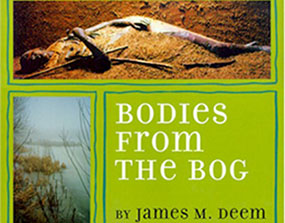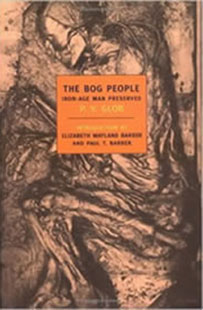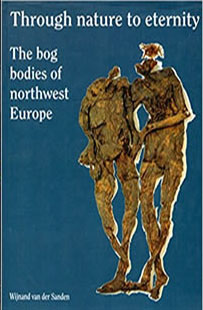Paperback edition, 2003.
|
~~ Suggestions for Visiting Bogs and Bog Bodies ~~ ~~ Bog Body Stories ~~ Related Books by James M Deem: Bodies from the Ice ~~ Bodies from the Ash ~~ ~~ |
The Discovery of Windeby I
In 1952, on the Windeby estate near Schleswig, Germany, two bodies were found in a small bog. The owners had decided to cut the peat from the bog and sell it for fuel. Shortly after, workers discovered a body (originally thought to be female) now known as Windeby I. Although the peat-cutting machinery had already severed one of the legs, a foot, and a hand, work was stopped immediately to study the discovery. A short time later, a second body (a male known as Windeby II) was found sixteen feet away. An examination revealed that he had been strangled first and then placed in the bog. Sharpened, forked branches had been jammed into the peat around him to make sure that he stayed put.
But it was the first body that intrigued researchers.
Professor P. V. Glob (who studied Windeby I after its discovery) believed the body to be a fourteen year old girl. In his book, The Bog People: Iron Age Man Preserved, Glob described the body's position in the peat:
She lay on her back, her head twisted to one side, her left arm outstretched.... The right arm was bent in against the chest, as if defensively, while the legs were lightly drawn up, the left over the right. The head, with its delicate face, and the hands, were preserved best: the chest had completely disintegrated and the ribs were visible.... The hair, reddish from the effects of the bog acids but originally light blond, was of exceptional fineness but had been shaved off with a razor on the left side of the head.
The body's eyes were blindfolded with a strip of cloth woven from brown, yellow, and red threads. The person had drowned in the first century A.D., and the death was not an accident--the body was anchored by a large stone and branches from a birch tree. Glob imagined the person being "led naked out on to the bog with bandaged eyes ... and drowned in the little peat pit, which must have held twenty inches of water or more."
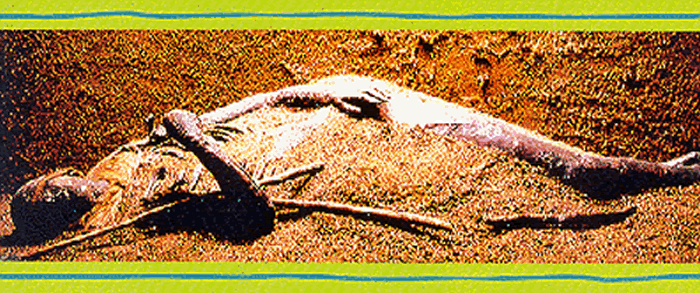

Another Study of Windeby I
In 1970, the body was reexamined. So little of it remained that scientists could not say with certainty that the body was female.
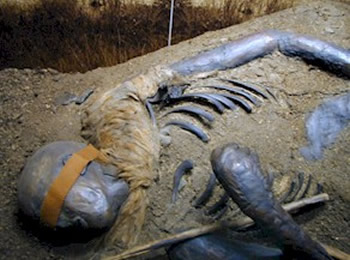 Over thirty years later, a third look at Windeby I was published in National Geographic (September 2007) and revealed more definitive information.
Over thirty years later, a third look at Windeby I was published in National Geographic (September 2007) and revealed more definitive information.
A professor from North Dakota State University tested a DNA sample from the body and concluded that it was indeed male. What's more, the hair had not been shaved from half of the head. Rather, the professor believes that it became dislodged during the careless excavation.
Originally, scientists concluded that Windeby I had died an unnatural death during the First Century A.D. The body seemed to have been prepared for death in a number of unusual ways. First, like some other bog bodies that have been found, half of the head had been shaved of hair. Second, a woolen headband had been used to blindfold the eyes. Finally, a collar had been placed around the neck. As a result of these special preparations, most researchers agreed initially that Windeby I was not sacrificed to the gods.
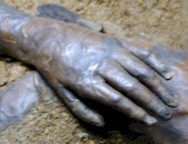 Although they could not find any wounds on the body, scientists suspected that the person was drowned in the bog, held down in perhaps twenty inches of water by some branches and a large stone. But they had no idea why Windeby I was killed. Could the person have been a criminal who was being executed in a gruesome way? Could the person have been afflicted with some type of disease that may have marked her for an early death? No one will ever really know, though many theories have been proposed.
Although they could not find any wounds on the body, scientists suspected that the person was drowned in the bog, held down in perhaps twenty inches of water by some branches and a large stone. But they had no idea why Windeby I was killed. Could the person have been a criminal who was being executed in a gruesome way? Could the person have been afflicted with some type of disease that may have marked her for an early death? No one will ever really know, though many theories have been proposed.
More recent research on the body's bones indicates that the young person had been quite sick during his life time and "may have simply died of natural causes." One German scholar suggested that Windeby I may have been blindfolded at burial "to protect the living from the gaze of the dead."

The Landesmuseum (Schleswig, Germany) displays Windeby I and four other bog bodies in separate dioramas: men from Damendorf, Rendswühren, and Dätgen and a very interesting skull from Osterby. All are named for the areas where they were discovered, and all were apparently sacrificed.

